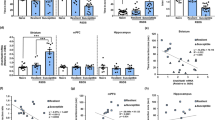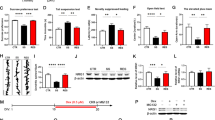Abstract
Rationale
There is accumulating evidence to support the idea that brain-derived neurotrophic factor (BDNF) is involved in stress resilience. However, the precise molecular mechanisms underlying resilience in major depressive disorder (MDD) remain unknown.
Objective
The objective of this study was to explore the role of methyl CpG binding protein 2 (MeCP2) and the BDNF/tropomyosin-receptor-kinase B (TrkB) signaling pathway in the stress resilience to chronic social defeat stress (CSDS) in mice.
Results
We found that the overexpression of MeCP2 inhibited BDNF transcription, resulting in BDNF mRNA and protein downregulation in neuro-2a cells. The overexpression of MeCP2 increased S80-MeCP2 and decreased S421-MeCP2, BDNF, the ratio of S133-cyclic AMP response element binding protein (CREB)/CREB and p-TrkB/TrkB expression in neuro-2a cells. In addition, using the CSDS mouse model, we found that MeCP2 mRNA levels were decreased in the medial prefrontal cortex (mPFC) of resilient mice and increased in the hippocampus of susceptible mice. BDNF exon IV promoter and BDNF mRNA levels were decreased in the mPFC and hippocampus of susceptible mice. Finally, MeCP2 and S80-MeCP2 protein levels were increased in the mPFC and hippocampus of susceptible mice, whereas the protein expression of S421-MeCP2 and BDNF, the ratio of S133-CREB/CREB, and the levels of p-TrkB/TrkB were decreased in susceptible mice.
Conclusions
These data suggest that the overexpression of MeCP2 inhibits BDNF transcription in neuro-2a cells. The inhibition of MeCP2 expression and activation of the BDNF/TrkB signaling pathway may confer stress resilience in CSDS mice.




Similar content being viewed by others
References
Bambah-Mukku D, Travaglia A, Chen DY, Pollonini G, Alberini CM (2014) A positive autoregulatory BDNF feedback loop via C/EBPβ mediates hippocampal memory consolidation. J Neurosci Off J Soc Neurosci 34:12547–12559
Berton O, McClung CA, Dileone RJ, Krishnan V, Renthal W, Russo SJ, Graham D, Tsankova NM, Bolanos CA, Rios M, Monteggia LM, Self DW, Nestler EJ (2006) Essential role of BDNF in the mesolimbic dopamine pathway in social defeat stress. Science 311:864–868
Bjorkholm C, Monteggia LM (2016) BDNF - a key transducer of antidepressant effects. Neuropharmacology 102:72–79
Cao Q, Zou Q, Zhao X, Zhang Y, Qu Y, Wang N, Murayama S, Qi Q, Hashimoto K, Lin S, Zhang JC (2022) Regulation of BDNF transcription by Nrf2 and MeCP2 ameliorates MPTP-induced neurotoxicity. Cell Death Discov 8:267
Castrén E (2014) Neurotrophins and psychiatric disorders. Handb Exp Pharmacol 220:461–479
Golden SA, Covington HE 3rd, Berton O, Russo SJ (2011) A standardized protocol for repeated social defeat stress in mice. Nat Protoc 6:1183–1191
Hashimoto K (2010) Brain‐derived neurotrophic factor as a biomarker for mood disorders: an historical overview and future directions. Psychiatry Clin Neurosci 64(4):341–357
Hashimoto K (2019) Rapid-acting antidepressant ketamine, its metabolites and other candidates: A historical overview and future perspective. Psychiatry Clin Neurosci 73:613–627
Hashimoto K (2020) Molecular mechanisms of the rapid-acting and long-lasting antidepressant actions of (R)-ketamine. Biochem Pharmacol 177:113935
Hashimoto K, Shimizu E, Iyo M (2004) Critical role of brain-derived neurotrophic factor in mood disorders. Brain Res Brain Res Rev 45:104–114
Klose RJ, Bird AP (2006) Genomic DNA methylation: the mark and its mediators. Trends Biochem Sci 31:89–97
Koponen E, Lakso M, Castren E (2004a) Overexpression of the full-length neurotrophin receptor trkB regulates the expression of plasticity-related genes in mouse brain. Brain Res Mol Brain Res 130:81–94
Koponen E, Rantamäki T, Voikar V, Saarelainen T, MacDonald E, Castrén E (2005) Enhanced BDNF signaling is associated with an antidepressant-like behavioral response and changes in brain monoamines. Cell Mol Neurobiol 25:973–980
Koponen E, Voikar V, Riekki R, Saarelainen T, Rauramaa T, Rauvala H, Taira T, Castren E (2004b) Transgenic mice overexpressing the full-length neurotrophin receptor trkB exhibit increased activation of the trkB-PLCgamma pathway, reduced anxiety, and facilitated learning. Mol Cell Neurosci 26:166–181
Lewis JD, Meehan RR, Henzel WJ, Maurer-Fogy I, Jeppesen P, Klein F, Bird A (1992) Purification, sequence, and cellular localization of a novel chromosomal protein that binds to methylated DNA. Cell 69:905–914
Lindholm JS, Castrén E (2014) Mice with altered BDNF signaling as models for mood disorders and antidepressant effects. Front Behav Neurosci 8:143
Mantamadiotis T, Lemberger T, Bleckmann SC, Kern H, Kretz O, Martin Villalba A, Tronche F, Kellendonk C, Gau D, Kapfhammer J, Otto C, Schmid W, Schutz G (2002) Disruption of CREB function in brain leads to neurodegeneration. Nat Genet 31:47–54
Martinowich K, Hattori D, Wu H, Fouse S, He F, Hu Y, Fan G, Sun YE (2003) DNA methylation-related chromatin remodeling in activity-dependent BDNF gene regulation. Science 302:890–893
Montminy M (1997) Transcriptional regulation by cyclic AMP. Annu Rev Biochem 66:807–822
Nair A, Vaidya VA (2006) Cyclic AMP response element binding protein and brain-derived neurotrophic factor: molecules that modulate our mood? J Biosci 31:423–434
Nestler EJ, Barrot M, DiLeone RJ, Eisch AJ, Gold SJ, Monteggia LM (2002) Neurobiology of depression. Neuron 34:13–25
Palomer E, Carretero J, Benvegnu S, Dotti CG, Martin MG (2016) Neuronal activity controls Bdnf expression via Polycomb de-repression and CREB/CBP/JMJD3 activation in mature neurons. Nat Commun 7:11081
Shrivastava A, Desousa A (2016) Resilience: A psychobiological construct for psychiatric disorders. Indian J Psychiatry 58:38–43
Tao JF, Hu KP, Chang Q, Wu H, Sherman NE, Martinowich K, Klose RJ, Schanen C, Jaenisch R, Wang WD, Sun YE (2009) Phosphorylation of MeCP2 at Serine 80 regulates its chromatin association and neurological function. Proc Natl Acad Sci USA 106:4882–4887
Tremblay RG, Sikorska M, Sandhu JK, Lanthier P, Ribecco-Lutkiewicz M, Bani-Yaghoub M (2010) Differentiation of mouse Neuro 2A cells into dopamine neurons. J Neurosci Methods 186:60–67
Tsankova NM, Berton O, Renthal W, Kumar A, Neve RL, Nestler EJ (2006) Sustained hippocampal chromatin regulation in a mouse model of depression and antidepressant action. Nat Neurosci 9:519–525
Wu G, Feder A, Cohen H, Kim JJ, Calderon S, Charney DS, Mathe AA (2013) Understanding Resilience. Front Behav Neurosci 7:10
Yang B, Yang C, Ren Q, Zhang JC, Chen QX, Shirayama Y, Hashimoto K (2016) Regional differences in the expression of brain-derived neurotrophic factor (BDNF) pro-peptide, proBDNF and preproBDNF in the brain confer stress resilience. Eur Arch Psychiatry Clin Neurosci 266:765–769
Yang C, Shirayama Y, Zhang JC, Ren Q, Hashimoto K (2015) Regional differences in brain-derived neurotrophic factor levels and dendritic spine density confer resilience to inescapable stress. Int J Neuropsychopharmacol 18: https://doi.org/10.1093/ijnp/pyu121
Yao W, Cao Q, Luo S, He L, Yang C, Chen J, Qi Q, Hashimoto K, Zhang JC (2022) Microglial ERK-NRBP1-CREB-BDNF signaling in sustained antidepressant actions of (R)-ketamine. Mol Psychiatry 27:1618–1629
Yao W, Lin S, Su J, Cao Q, Chen Y, Chen J, Zhang Z, Hashimoto K, Qi Q, Zhang JC (2021) Activation of BDNF by transcription factor Nrf2 contributes to antidepressant-like actions in rodents. Transl Psychiatry 11:140
Zhang JC, Yao W, Dong C, Han M, Shirayama Y, Hashimoto K (2018) Keap1-Nrf2 signaling pathway confers resilience versus susceptibility to inescapable electric stress. Eur Arch Psychiatry Clin Neurosci 268:865–870
Zhang JC, Yao W, Hashimoto K (2016) Brain-derived Neurotrophic Factor (BDNF)-TrkB Signaling in Inflammation-related Depression and Potential Therapeutic Targets. Curr Neuropharmacol 14:721–731
Zhao T, Huang GB, Muna SS, Bagalkot TR, Jin HM, Chae HJ, Chung YC (2013) Effects of chronic social defeat stress on behavior and choline acetyltransferase, 78-kDa glucose-regulated protein, and CCAAT/enhancer-binding protein (C/EBP) homologous protein in adult mice. Psychopharmacology 228:217–230
Zhou X, Moon C, Zheng F, Luo Y, Soellner D, Nunez JL, Wang H (2009) N-methyl-D-aspartate-stimulated ERK1/2 signaling and the transcriptional up-regulation of plasticity-related genes are developmentally regulated following in vitro neuronal maturation. J Neurosci Res 87:2632–2644
Zhou Z, Hong EJ, Cohen S, Zhao WN, Ho HY, Schmidt L, Chen WG, Lin Y, Savner E, Griffith EC, Hu L, Steen JA, Weitz CJ, Greenberg ME (2006) Brain-specific phosphorylation of MeCP2 regulates activity-dependent Bdnf transcription, dendritic growth, and spine maturation. Neuron 52:255–269
Acknowledgements
This work is supported by the Research Fund Program of Guangdong Provincial Key Laboratory of Traditional Chinese Medicine Informatization (2021202 to WY), Huang Zhendong Research Fund for Traditional Chinese Medicine of Jinan University (201911 to JC), National Natural Science Foundation of China (No. 81973748, 82174278 to JC), and Natural Science Foundation of Guangdong Province of China (2022A1515012512 to JZ).
Author information
Authors and Affiliations
Contributions
WY and JC conceived the project, designed the experiments, analyzed the data, and wrote the manuscript. LXH, LJH, and RJM designed and performed most of the experiments and analyzed the data. JZ and SL assisted with data analysis and interpretation and critically read the manuscript. All authors read and approved the final manuscript.
Corresponding authors
Ethics declarations
Conflict of interest
The authors declare that they have no conflicts of interest.
Additional information
Publisher's note
Springer Nature remains neutral with regard to jurisdictional claims in published maps and institutional affiliations.
Rights and permissions
About this article
Cite this article
Huang, L., He, L., Ma, R. et al. The role of MeCP2 and the BDNF/TrkB signaling pathway in the stress resilience of mice subjected to CSDS. Psychopharmacology 239, 2921–2929 (2022). https://doi.org/10.1007/s00213-022-06176-8
Received:
Accepted:
Published:
Issue Date:
DOI: https://doi.org/10.1007/s00213-022-06176-8




